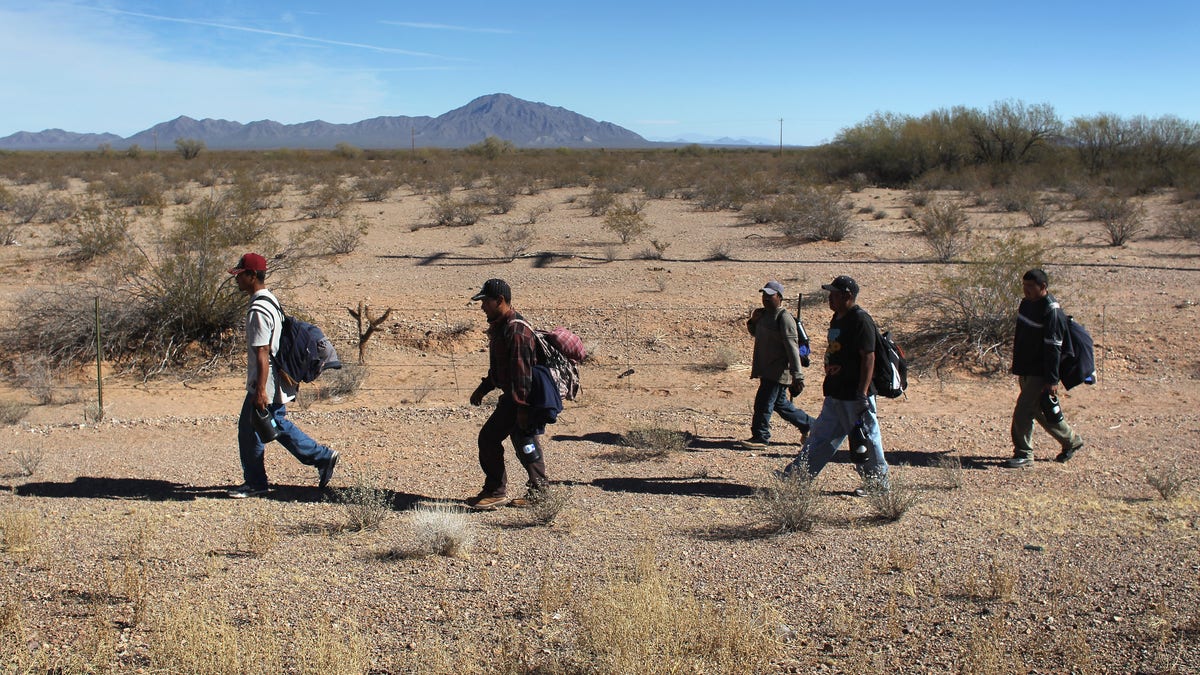
TOHONO O'ODHAM NATION, AZ - JANUARY 19: Undocumented Mexican immigrants walk through the Sonoran Desert after illegally crossing the U.S.-Mexico border border on January 19, 2011 into the Tohono O'odham Nation, Arizona. The immigrants said they had wandered the desert lost for a week after crossing from Mexico into the vast Indian reservation at night. Exhausted, they requested the Border Patrol to pick them up and take them to the U.S.-Mexico border, from where they would return to their homes in the Mexican state of Sonora. They had come, they said, to reach Phoenix and find work in construction or landscaping. All said they had worked in Arizona before. (Photo by John Moore/Getty Images) (2011 Getty Images)
Who should make day-to-day operational decisions on border security? Boots on the ground or bureaucrats back at headquarters in Washington, D.C.?
Any Border Patrol officer who has been on his or her beat for any amount of time can tell you exactly what tools are needed in order to do the job effectively. The men and women working the borders know their areas well and what it takes to curb illegal border crossers.
Much of the surveillance on our border has traditionally relied on static Towers to monitor border threats. That approach is outdated. Today’s smuggling and trafficking rings are highly mobile, so our border security agencies must move where the threat takes them.
Unfortunately, border security has too often fallen victim to a top-down management approach.
Last year’s influx of unaccompanied minors and fears of another spike this summer, along with the ongoing concerns associated with economic migrants and drug trafficking, demonstrate that Border Patrol needs field commanders making the calls on what is needed to ensure undocumented border crossers are apprehended and that potential crossers are discouraged. Taking a page from the military, Border Patrol’s leaders in the field need similar flexibility and deference in order to effectively do their jobs.
So in an effort to reshuffle the deck in a way that acknowledges the insight and experience of professionals in the field, Secretary of Homeland Security Secretary Jeh Johnson last November wisely called for the creation of the Southern Border Joint Task Force.
- Sen. Marco Rubio goes to all-important Iowa in first trip as presidential candidate
- Hillary Clinton doesn’t speak Spanish, but her campaign website does
- U.S. court rules that Mexico family of teen killed by Border Patrol agent cannot sue him
- Jeb Bush says Republican voters are open-minded on immigration issues
- Marco Rubio’s announcement drew a diverse crowd – young, old, rich and poor
- Marco Rubio announces he’s running for president, vows to protect American Dream
- Immigration Hackathon: Undocumented Youth And Tech Giants Come Together
- Immigration “Rally for Citizenship”
- ‘Dream 9’ Released From Immigration Detention
- U.S. Children of Deportees Plead for a Change to the Immigration System
- Key Players in the Quest for Immigration Reform
These three newly created Joint Task Forces (JTFs) are designed to secure the land, air and sea from terrorism and related illegal activity while allowing for lawful trade, travel and commerce. The JTFs were created by incorporating elements of the U.S. Coast Guard (USCG), U.S. Customs and Border Patrol (CBP), U.S. Immigration and Customs Enforcement (ICE), and U.S. Citizen and Immigration Services (USCIS).
In a memo sent to top members of the involved agencies, Secretary Johnson laid out his plan and ordered the realignment of personnel and the creation of headquarter capabilities for each JTF.
The three JTFs are dived into three separate components. From Norfolk, Va. JTF-East will focus on coastal borders, primarily the Gulf of Mexico, and will be led by the Coast Guard Vice Admiral William “Dean” Lee.
JTF–West, established in San Antonio, Texas, will head up efforts on land from San Diego to Brownsville and will be led by Commander Robert Harris of CBP, a veteran of the Border Patrol’s South Texas Campaign.
From the Washington, D.C. area, JTF-Investigations will support the first two task forces and will be led by ICE-HSI Special Agent in Charge David Marwell.
This new model seeks a “supported-supporting” approach, whereby agencies interact and support one another. The idea is right for the times, helping to ensure that the JTFs’ missions are not diluted by a political ping-pong over control.
Ensuring that field leadership can make decisions according to the mobilized threat is paramount. For example, much of the surveillance on our border has traditionally relied on static towers to monitor border threats. That approach is outdated. Today’s smuggling and trafficking rings are highly mobile, so our border security agencies must move where the threat takes them. Outfitting our men and women with personal surveillance equipment and the latest mobile surveillance-capable vehicles, such as the RaVEN-Mobile by Telephonics, that can move wherever the threat is will make a big difference in effectiveness.
Providing border agencies with modern equipment that is reflective of the challenge of today’s border security environment has been an ongoing challenge. Reports of outdated radios, lack of communication coverage, obsolete surveillance equipment and ships need to be addressed soon or good outcomes will be elusive.
There is no better time to realign our border strategy to a way that reflects today’s security challenges.
The JTF model has been adopted by our military on countless occasions. Whether the same model, which grants leaders in the field increased authority, can be adopted within of one of the most highly politicized domestic issues of our time is another issue altogether. We will see if Washington, D.C.’s bureaucracy has the will to keep its hands off this new and necessary border security model.
